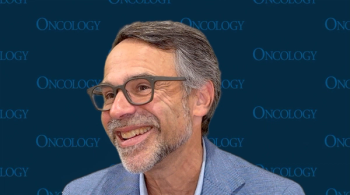
Oncology NEWS International
- Oncology NEWS International Vol 5 No 1
- Volume 5
- Issue 1
Arkansas Pioneers 'Total Therapy' for Multiple Myeloma
LITTLE ROCK, Ark--Little prog-ress has been made during the last 30 years toward improving the prognosis of patients with myeloma. Because of the patients' often brittle condition and advanced age, dose intensity concepts had not been evaluated until the late Tim McElwain from the Royal Marsden Hospital reported responses to high-dose melphalan [Alkeran] at 140 mg/m² in patients with refractory disease or high-risk newly diagnosed patients.
LITTLE ROCK, Ark--Little prog-ress has been made during the last30 years toward improving the prognosis of patients with myeloma.Because of the patients' often brittle condition and advancedage, dose intensity concepts had not been evaluated until thelate Tim McElwain from the Royal Marsden Hospital reported responsesto high-dose melphalan [Alkeran] at 140 mg/m² in patientswith refractory disease or high-risk newly diagnosed patients.
Barlogie and colleagues built on this approach and introducedautologous bone marrow transplantation (ABMT) in support of myeloablativetherapy with melphalan, 140 mg/m², and total body irradiation(TBI), achieving complete responses (CRs) in 20% to 25% of refractorymultiple myeloma patients.
The Arkansas Cancer Research Center has now conducted double transplantsat an intended interval of 6 months in 470 myeloma patients (180newly diagnosed, 290 previously treated). The preparative regimensconsisted of melphalan, 200 mg/m², for the first and againfor the second transplant (PR or better), or melphalan, 140 mg/m²plus TBI (less thanPR).
Treatment-related mortality during the first year from transplantwas 6%; CR was 34%, and higher with sensitivity to prior standardtherapy and limited prior treatment of 12 months or less. Event-freeand overall survival from transplant were 27 and 40 months, respectively,and superior with low beta-2-microglobulin of 2.5 mg/L or lessand C-reactive protein of 0.4 mg/dL or less prior to ABMT.
The absence of certain chromosomal abnormalities involving 11qand deletions of chromosome 13 turned out to be the most favorablefeature for long-term prognosis. At 6 months, analysis identifiedboth induction of CR and the application of two transplants within6 months as additional significant variables extending both event-freeand overall survival.
Timely application of two transplants seems to improve patients'prognosis by raising the incidence of true CR into the 50% range,a threshold probably needed to achieve durable disease controland possibly cure.
"Total Therapy" vs Standard SWOG Treatment
At the American Society of Hematology meeting, the Arkansas groupreported on a historical comparison between "Total Therapy"and standard SWOG* treatment for newly diagnosed myeloma. "TotalTherapy" was given to 155 newly diagnosed patients and consistedof remission induction with VAD ´ 3, high dose cyclophosphamidewith PBSC collection and EDAP (etoposide, dexamethasone, cytarabineand cisplatin) followed by 2 autotransplants in support of melphalan200 mg/m² × 2 (for PR or better after first transplant)or melphalan 200 mg/m² followed by melphalan 140 mg/m²+ TBI (850-1120 cGy) (for less than PR post first transplant).Standard treatment employed VMCP/VBAP, VMCPP/VBAPP (with morefrequent prednisone) or VAD in 884 patients. Three-year event-freeand overall survival after "Total Therapy" were 60%and 76%, respectively, compared to 30% and 50% among SWOG patients(both P = .0001). In order to account for differences in diseaseand host variables, Cox regression analysis and a highly stratifiedlog rank test were employed (matching patients for age, creatinineand B2M). "Total Therapy" was superior to standard treatment,reducing the relative risk of relapse to 0.47 (P = .0001) andof death to 0.52 (P = .001). These data strongly suggest thatmyeloablative therapy as practiced with "Total Therapy"was superior to standard regimens (ASH abstract 816).
Comparison of total therapy results with the single transplantarm of the French Myeloma Intergroup (IFM) study using melphalan,140 mg/m², plus TBI, 800 cGy, reveals virtually identicalCR rates after one transplant (23% and 22%, respectively).
It is possible that the longer median duration of event-free survivalof 43 months with total therapy, as opposed to 27 months in theIFM transplantation group results from additional tumor cytoreductionachieved with a second transplant course, although differencesin prognostic factors in the patient populations cannot be excluded.
Based on earlier pilot trials by our group, the IFM is now formallycomparing double vs single transplants and marrow vs PBSC as thesource of hematopoietic stem cells.
US Randomized Trial.
A high priority trial--US Intergroup Trial INT-141 (SWOG 9321)--iscurrently underway that evaluates, essentially, early vs latetransplants in newly diagnosed patients. Patients are inducedwith 4 cycles of VAD, followed by high-dose cyclophosphamide forPBSC collection and randomization to melphalan, 140 mg/m²,plus TBI, 1,200 cGy, vs standard therapy with VBMCP (M2 protocol).
Those achieving tumor mass reduction of 75% or more are randomizedto interferon maintenance or observation. Upon relapse on VBMCP,patients can be salvaged with ABMT. Patients up to age 55 withan HLA-matched sibling donor are offered an allogeneic transplant.
While the US trial addresses the importance of timeliness of myeloablativetherapy, the current French trial will determine the usefulnessof further dose intensification with double transplants.
Articles in this issue
almost 30 years ago
HCFA Reevaluations May Affect Chemo Administration Cost Codesalmost 30 years ago
Breast Cancer Info Now on Internetalmost 30 years ago
HDC/ABMT Has Benefits in Multiple Myelomaalmost 30 years ago
Clinical Trial to Study MoAb 17-1A as An Adjuvant to Colon Cancer Therapyalmost 30 years ago
Reporting of Study Comparing Casodex, Eulexin Is Questionedalmost 30 years ago
Limits on Tamoxifen Duration Questionedalmost 30 years ago
ACRO Forecasts Radiologist Surplusalmost 30 years ago
Potency Status Before RT, Not Dose, Determines Post-RT Functionalmost 30 years ago
Dr. Klausner Outlines Goals for NCIalmost 30 years ago
Difficulties in Translating Relative Risks Into Absolute RiskNewsletter
Stay up to date on recent advances in the multidisciplinary approach to cancer.


















































































